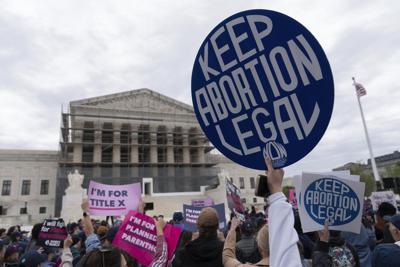Fewer people crossed state lines to obtain abortions in 2024 than a year earlier, a new survey has found.
The Guttmacher Institute, a research organization that supports abortion rights, estimates in a report released Tuesday that the overall number of clinician-provided abortions in states where it's legal rose by less than 1% from 2023 to 2024.
But the number of people crossing state lines for abortions dropped by about 9%.
The report, based on a monthly survey of providers, is the latest look at how the abortion landscape in the U.S. has evolved since the Supreme Court reversed Roe v. Wade in 2022 in a ruling that eliminated a national constitutional right to abortion and opened the door to state bans and restrictions.
The total number of abortions continued to rise
Guttmacher estimates there were 1.04 million abortions in 2024, up about 1% from its total the previous year.
Multiple studies have found that the total number of abortions in the U.S. has risen since Dobbs, despite some states implementing bans.
Twelve states currently enforce abortion bans with limited exceptions at all stages of pregnancy. Four more have bans that kick in after about six weeks, which is before many women know they’re pregnant.
Guttmacher's tally does not capture self-managed abortions such as people obtaining abortion pills from community networks, foreign pharmacies or through telehealth from medical providers in states that have laws intended to protect those who send pills into places with bans. There’s a of such laws. But found that the number of telehealth pills being sent into states with bans has been growing and accounted for about 1 in 10 abortions in the U.S. by the summer of 2024.
Isaac Maddow-Zimet, a data scientist at Guttmacher, said even though the number of abortions is up, it's likely some people who would like to end their pregnancies are not able to.
“We know that some people are accessing abortion through telehealth,” he said. “And we know it’s not an option for everybody.”
Travel for abortions declined
The number of people crossing state lines for abortions dropped to about 155,000 from nearly 170,000.
The year-to-year impact varies by state.
For instance, about 1 in 8 abortions in Florida in the first half of 2023 were provided to people coming from out of state. By the second half of 2024 — when a ban on abortions after the first six weeks of pregnancy took effect — only about 1 in 50 were for people from another state.
More people traveled to states including Virginia and New York after the Florida law took hold.
A drop in people traveling to Minnesota could be linked to abortions being offered again in clinics in Wisconsin.
Most abortions in Kansas are provided to people from elsewhere and the number grew as .
Obstacles under bans affect some women more than others
A working paper released in March provided different insight into the impact of the bans.
It found that birth rates rose from 2020 to 2023 in counties farther from abortion clinics. Rates rose faster for Black and Hispanic women, those with lower education levels, and people who are unmarried.
“The takeaway is that distance still matters,” said Caitlin Myers, a Middlebury College economic professor and one of the authors of the working paper published by the ��ɫtv Bureau of Economic Research. “It really wasn’t obvious that that would be the case.”
“These bans are more than just policies; these are direct attacks on bodily autonomy," said Regina Davis Moss, president and CEO of In Our Own Voice: ��ɫtv Black Women’s Reproductive Justice Agenda.
The bans also exacerbate the huge disparities in maternal mortality for Black women in the U.S, she said. at a rate nearly 3.5 times higher than white women in 2023.
“We’re going to be faced with increasing numbers of births, which is going to increase the maternal mortality rate, the infant mortality rate and inequities in care,” she said. “It’s very upsetting and sad.”
Bree Wallace, director of case management at the Tampa Bay Abortion Fund in Florida, which helps with the logistics and costs of abortions, said people who consider getting an abortion don’t always know their options.
“Many people don’t know their choices or think that it’s just not possible to go out of state,” she said. “A lot of people hear ‘ban’ or ‘six-week ban’ in their state and that’s it.”
___
Associated Press science writer Laura Ungar contributed from Louisville, Kentucky.







































